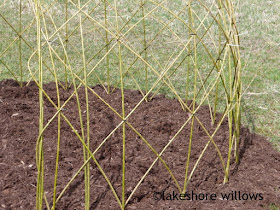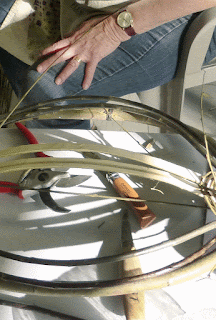We are now offering kits and instructions for LIVING WILLOW PLAY HUTS AND TUNNELS.
It is becoming increasingly popular to install living willow huts and tunnels at daycares, school yards and your own yard for young children to play in.
Not only are they beautiful structures (when maintained properly), they also give your child a sense of nature as it is a living structure.
So, now we offer kits for your structure - available in spring after harvest of the willow rods - and they come with instructions on how to install.
Actually, we have decided to post the instructions right here for everyone to see and use if you have access to dormant willow rods.
The hut and/or tunnel can be created in different sizes which the kits will reflect, but the instructions are the same.
The ground should be level and without stones approximately 30 cm (1 foot) into the soil.
Step 1:
Start by marking the circumference of the hut.
In my following photos I DID NOT DO THIS, BUT I RECOMMEND THAT YOU DO IT:
Preferably you will put down a heavy landscape fabric that extends about 1 foot beyond the floor of the structure all the way round - BEFORE YOU START INSERTING THE RODS. Some people also use a heavy, black plastic, but I find that it can be too slippery when wet for children to play on.
Step 2:
Mark the spots for the entrance (approximately 4 feet wide)

Insert 3 long rods together, pushing them about 30 cm (1 foot) into the ground.
Twist the rods together and secure with a zip tie.
Repeat at other end of the entrance.
Step 3:
Select your longest and heaviest rods and insert from one door post to the other all the way around the circumference approximately 30 cm (1 foot) apart and pushed 30 cm (1 foot) into the ground.


Twist the two parts for the doorway together and secure with several zip-ties.
Step 4:
Insert 2 additional rods for each already installed rod.
Push them approx 30 cm ( 1 foot) into the ground on either side of the existing rod.
Insert at an angle.
Step 5:
Start weaving the rods together on a diagonal (over, under etc) and tie at the first cross with a zip-tie, elastic or other.
Continue weaving higher up and around the door "poles"
Step 6:
If you want your structure to be higher than your willow rods will allow, this is where you stop.
Make sure that all the crossings of willow rods are securely fastened.
Skip step 7 and leave the structure to grow.
When the growth on the rods is long enough for your desired height of the structure you simply continue at STEP 7.
This could be at the end of the first growing season, sooner or even later - into the 2nd
growing season.
Step 7:
Gather the tops of the rods in the middle, twisting them together and/or secure with ties.
Step 8:
Cover the ground in and beyond the structure with a heavy landscape cloth (if you haven't already done so) and a good layer of mulch to prevent weeds to grow and to keep the soil moist.
As the willow rods don't have any roots when you install them, it is VERY IMPORTANT to keep the soil around the rods MOIST AT ALL TIMES DURING THE FIRST GROWING SEASON OR TWO.
This is best done by installing a drip-hose and connect it to a timer on the water tap.
Our kit for the play hut or tunnel includes everything you need to install the project:
Dormant willow rods
Heavy landscape fabric to cover the ground inside + approximately 30 cm (1 foot) beyond the edge of the structure.
Staples to keep the cloth in place.
Ties to hold the rods together.
In addition to that you will need:
Mulch to cover the area in a thick layer.
Drip hose and a timer to water the structure daily during at least the first growing season.
Maintenance:
As the willow start to grow you want to weave the new shoots into the structure to make it stronger and denser.

When the new shoots are about 60 cm (2 feet) long you want to weave them into the structure.
If you wait much longer they may become too stiff for you to do it without breaking or kinking them.
You can continue to do so in future years if you want the structure to be denser.
Alternatively the structure should be trimmed twice a year to keep looking nice.
Do not despair if a couple of your willow rods don't take or die. You can always replace them with growth from some of the other rods as they grow.
INSTALLING A PLAY TUNNEL
Install a play tunnel in exactly the same way as explained above for the play hut. The shape of the structure is just different.
HAVE FUN!
Words and photos by Lene Rasmussen,Willows.



























